
Royal Botanic Gardens, Kew, is a non-departmental public body in the United Kingdom sponsored by the Department for Environment, Food and Rural Affairs. An internationally important botanical research and education institution, it employs 1,100 staff. Its board of trustees is chaired by Dame Amelia Fawcett.
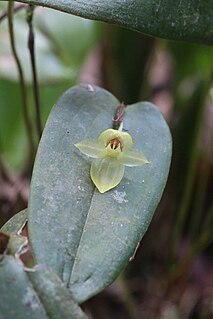
Pleurothallis is a genus of orchids commonly called bonnet orchids. The genus name is derived from the Greek word pleurothallos, meaning "riblike branches". This refers to the rib-like stems of many species. The genus is often abbreviated as "Pths" in horticultural trade.
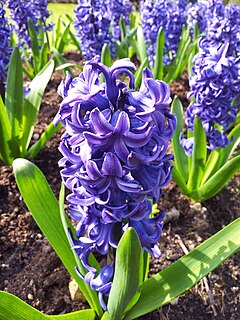
Hyacinthus is a small genus of bulbous, spring-blooming perennials. They are fragrant flowering plants in the family Asparagaceae, subfamily Scilloideae and are commonly called hyacinths. The genus is native to the area of the eastern Mediterranean from the north of Bulgaria through to the northern part of the region of Palestine.

Anthurium, is a genus of about 1000 species of flowering plants, the largest genus of the arum family, Araceae. General common names include anthurium, tailflower, flamingo flower, and laceleaf.

Muscari is a genus of perennial bulbous plants native to Eurasia that produce spikes of dense, most commonly blue, urn-shaped flowers resembling bunches of grapes in the spring. The common name for the genus is grape hyacinth, but they should not be confused with hyacinths. In the United States, they are also commonly referred to as bluebells, though certain regions reserve this name for bluebonnets instead. A number of species of Muscari are used as ornamental garden plants.
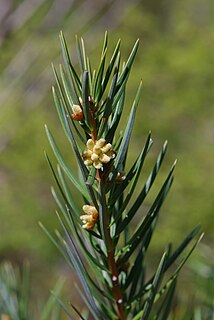
Keteleeria is a genus of three species of coniferous trees in the family Pinaceae first described as a genus in 1866.
Erismanthus is a plant genus of the family Euphorbiaceae first described as a genus in 1866. It is native to Southeast Asia and southern China.
- Erismanthus obliquusWall. ex Müll.Arg. - S Thailand, Malaysia, Borneo, Sumatra
- Erismanthus sinensisOliv. - Cambodia, Laos, Thailand, Vietnam, Hainan

Guzmania is a genus of over 120 species of flowering plants in the botanical family Bromeliaceae, subfamily Tillandsioideae. They are mainly stemless, evergreen, epiphytic perennials native to Florida, the West Indies, southern Mexico, Central America, and northern and western South America. They are found at altitudes of up to 3,500 m (11,483 ft) in the Andean rainforests.

Spirostachys is a plant genus of the family Euphorbiaceae first described as a genus in 1850. It is native to Africa. Zuloaga, F. O., O. Morrone, M. J. Belgrano, C. Marticorena & E. Marchesi. (eds.) 2008. Catálogo de las plantas vasculares del Cono Sur. Monographs in systematic botany from the Missouri Botanical Garden 107(1–3): i–xcvi, 1–3348.
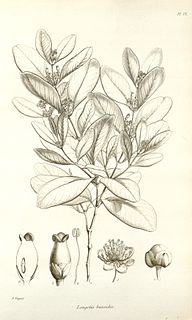
Longetia is a genus of plants under the family Picrodendraceae first described as a genus in 1866. It has only one known species, Longetia buxoides, endemic to New Caledonia.

Piranhea is a plant genus under the family Picrodendraceae described as a genus in 1866.
Chonocentrum is a genus of the family Phyllanthaceae described as a genus in 1922. It contains only known species, Chonocentrum cyathophorum, native to the State of Amazonas in northwestern Brazil.

The genus Tacca, which includes the batflowers and arrowroot, consists of flowering plants in the order Dioscoreales, native to tropical regions of South America, Africa, Australia, Southeast Asia, and various oceanic islands. In older texts, the genus was treated in its own family Taccaceae, but the 2003 APG II system incorporates it into the family Dioscoreaceae. The APG III and APG IV systems continue to include Tacca in Dioscoreaceae.

Copernicia is a genus of palms native to South America and the Greater Antilles. Of the known species and nothospecies (hybrids), 22 of the 27 are endemic to Cuba. They are fan palms, with the leaves with a bare petiole terminating in a rounded fan of numerous leaflets. The species are small to medium-sized trees growing to 5–30 m tall, typically occurring close to streams and rivers in savanna habitats.
Synapsis ilicifolia is a species of plant in the Schlegeliaceae family. It is endemic to the island of Cuba. It is the sole species in the genus Synapsis, which was described as a genus in 1866.
The World Checklist of Selected Plant Families is an "international collaborative programme that provides the latest peer reviewed and published opinions on the accepted scientific names and synonyms of selected plant families." Maintained by the Royal Botanic Gardens, Kew, it is available online, allowing searches for the names of families, genera and species, as well as the ability to create checklists.
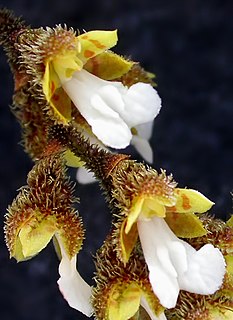
Saundersia is a genus of epiphytic orchids endemic to Brazil. It contains two species accepted as of June 2014:
Carruthersia is a genus of plants in the family Apocynaceae first described as a genus in 1866. It is native to the Philippines and to certain islands of the Western Pacific.

Stillingia lineata is a species of flowering plant in the family Euphorbiaceae, native to Réunion, Mauritius, the South China Sea, Malesia and Fiji.













